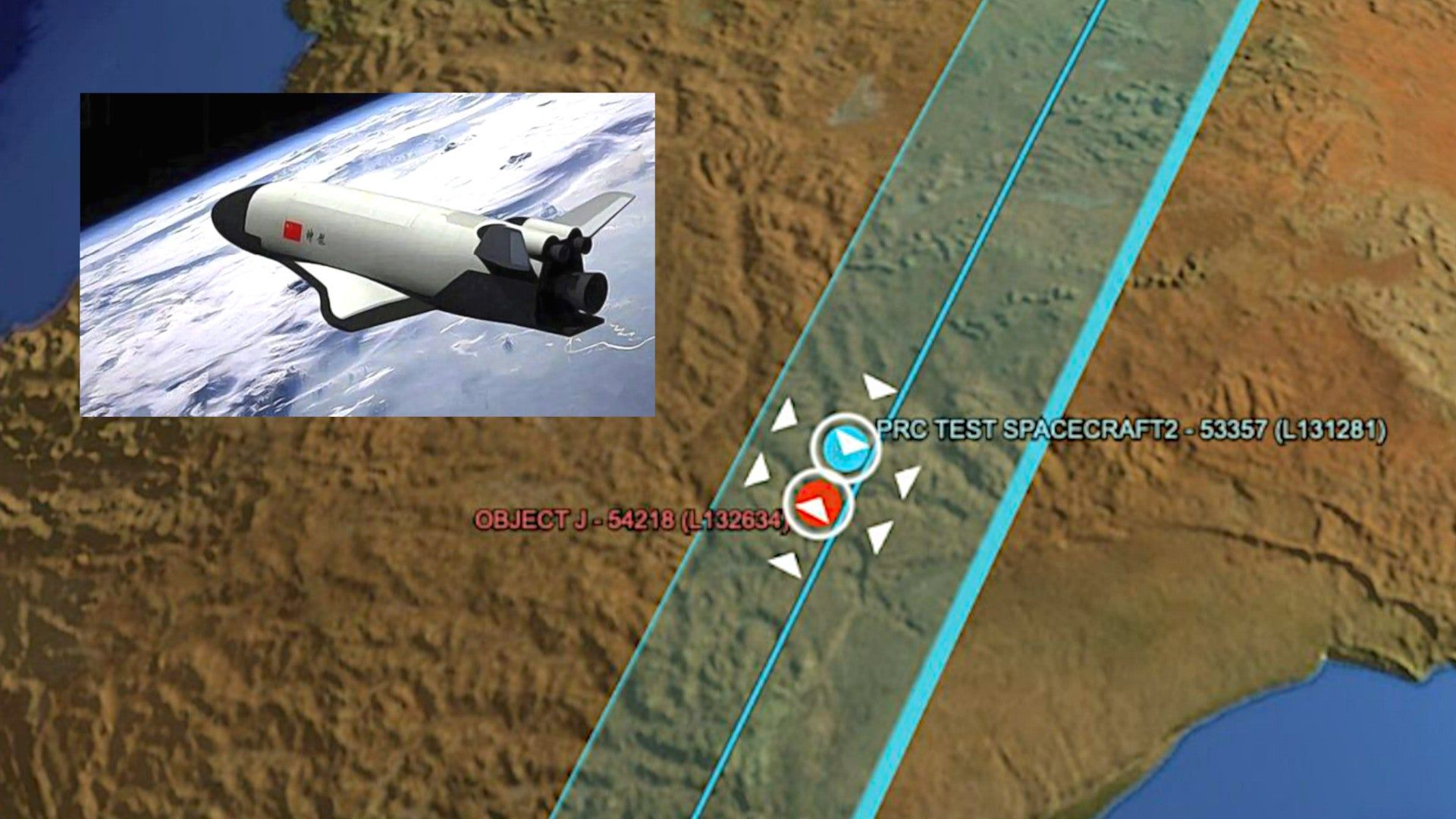Chinese Spaceplane Docked With Another Object Multiple Times Data Indicates
Private space services company LeoLabs says its data shows a Chinese reusable space vehicle, believed to be a miniature spaceplane design, docked with or otherwise captured a separate object on multiple occasions during its recent 276-day-long stint in orbit. A highly maneuverable space vehicle with this kind of capability could be used to surveil, disrupt and outright attack an opponent's space-based assets, as well as retrieve or otherwise interact with friendly ones.
The state-run China Aerospace Science and Technology Corporation, or CASC, announced the space vehicle had landed yesterday, but provided no details about its time in orbit. The company has provided similarly scant details following its launch on August 4, 2022. You can read more about what is known about this reported spaceplane, or at least Chinese work on designs of this kind, as well as the infrastructure to support its operations, in The War Zone's initial reporting on its return to Earth.
"Since its launch on 4 August 2022, we observed multiple large maneuvers raising the object’s altitude — as well as repeated deployments, formation flying, and docking of a sub-satellite Object J (NORAD ID 54218)," according to a post from LeoLabs on Twitter yesterday. "We’ve determined that the Test Spacecraft2 has propulsive capability and engaged in proximity operations with Object J, including what appeared to be at least two and possibly three capture/docking operations."
"Object J" is the name given by the U.S. military to an object that was launched along with the reusable space vehicle on August 4, 2022. Information about that object, to which the U.S.-Canadian North American Aerospace Defense Command (NORAD) also assigned the identification number 54218 to after its appearance, is contained within a public database available on the U.S. government-operated website Space-Track.org.
Interestingly, Object J/54218 does not appear to have been added to Space-Track.org's database until around two months after its launch. Eight other objects associated with the reusable space vehicle (cataloged as A through H) were added right after the launch on August 4, 2022. The letter "I" is skipped in this dataset to avoid confusion with the number one. Object A was the space vehicle itself, object B was the rocket booster, and objects C through H were debris from the launch, according to the U.S. military and NORAD.
Object J's "type" is listed in the database as "unknown."
Data available from Space-Track.org on the nine objects associated with the launch of the reusable Chinese space vehicle on August 4, 2022. Note the significant gap in the ID numbers between Objects H and J, highlighting how much later on the latter was added to the dataset. Space-Track.org
While it's unclear what Object J is, and what the Chinese reusable space vehicle was doing with it, if LeoLabs' data is accurate it would point to the latter having significant capabilities to maneuver close to and interact with other objects in orbit.
It is worth noting that the U.S. Space Force's two X-37B mini-space shuttles, which are often presented as broad analogs to Chinese spaceplane developments, have a number of these capabilities, as well. The X-37Bs are understood to be extremely maneuverable and can at least deploy payloads from a central bay, as well as an auxiliary payload bus attached to the rear of its fuselage. There has been much speculation over the years about the X-37B's potential offensive applications and it is now under the control of a unit tasked to carry out "orbital warfare," as you can read more about here.
One of the two X-37B orbital test vehicles ahead of its launch in 2020. The clamshell doors on top of its fuselage that cover its main payload bay are visibly disclosed and a service module is seen attached to its rear portion. U.S. Space Force
There are a number of relatively innocuous military and commercial/civilian applications of the ability of one object in space to get close to another and physically link up with it. On-orbit inspection, refueling, and servicing are all capabilities that the U.S. military and NASA, among many others, are interested in and that could help ensure the uninterrupted functioning of various space-based services in peacetime and during a future high-end conflict.
From a military perspective, being able to quickly assess damage to satellites and potentially get them back up and running could be essential in a major fight. The U.S. military, in particular, is heavily reliant on space-based assets to provide early warning, intelligence-gathering, navigation and weapon guidance, communications and data-sharing, and other support.
Highly maneuverable reusable space vehicles with the ability to manipulate objects in orbit could be used for a host of research, development, and test and evaluation purposes, as well.
However, a space vehicle with the ability to get very close to other objects in orbit and interact with them physically is inherently capable of acting as a weapon. There have long been concerns about so-called "killer satellites" that could launch a variety of different kinds of attacks on other objects in space.
A docking or capture capability on China's reusable space vehicle could indicate the presence of robotics arms or other protrusions that could be used to attempt to damage or destroy an opposing satellite. The space vehicle could be equipped with other kinds of offensive capabilities to pair with this, including electronic warfare systems or the ability to launch some kind of projectile.
A graphic depicting, in broad strokes, the various ways one satellite might attack another in space. A reusable space vehicle, such as a spaceplane, could carry out the same kinds of attacks. DIA
A highly maneuverable space vehicle can also just be used to collect intelligence and otherwise monitor other objects in orbit.
The Russian government has demonstrated a number of on-orbit anti-satellite capabilities in the past and Chinese authorities are understood to be interested in them, as well. Last year, the Chinese Shijian-21 satellite (SJ-21) maneuvered close to a BeiDou Navigation System satellite, grabbed it, and towed it into a so-called 'graveyard orbit,' demonstrating another capability that could be used to neutralize an opponent's space-based systems.
Both China and Russia are known to have significant ground-based anti-satellite assets and are looking to further expand those capabilities. This includes direct-ascent interceptors to physically knock down space-based assets and directed energy weapons capable of blinding optics and potentially damaging or destroying those sensors and other key systems on platforms in space. A leaked CIA document that recently emerged online suggests the Chinese government is interested in capabilities to not only neutralize, but actively hijack hostile satellites, as well.
China is "likely pursuing anti-satellite systems able to destroy satellites in geosynchronous orbit," Chief of Space Operations Gen. Chance Saltzman, head of the U.S. Space Force, told members of a subcommittee of the Senate Armed Services Committee back in March. "They are testing on-orbit satellite systems which could be weaponized as they have already shown the capability to physically control and move other satellites."
Chief of Space Operations Gen. Chance Saltzman testifies before the Senate Appropriations Subcommittee on Defense in April 2023. USAF
“If they can blind us, if they can interfere with those capabilities, or God forbid, destroy them completely. They know that will diminish our advantages," he added. “I can see interfering, I can see blinding, I can see some of those gray area kinds of attacks on our capabilities to try and put us behind the eight ball."
"Right now, Space Force is dealing with what Thompson calls 'reversible attacks' on U.S. government satellites (meaning attacks that don’t permanently damage the satellites) 'every single day,'" The Washington Post reported in 2021 based on an interview with Space Force's Vice Chief of Space Operations Gen. David Thompson. "Both China and Russia are regularly attacking U.S. satellites with non-kinetic means, including lasers, radio frequency jammers, and cyber attacks," he said.
It will certainly be interesting to see if more information emerges about the on-orbit abilities of the Chinese reusable space vehicle that recently return to Earth now that LeoLabs has put forward its assessment of its activities. Whatever the case, the company's data adds to the already growing evidence of growing Chinese anti-satellite capabilities.
Source: The War Zone


